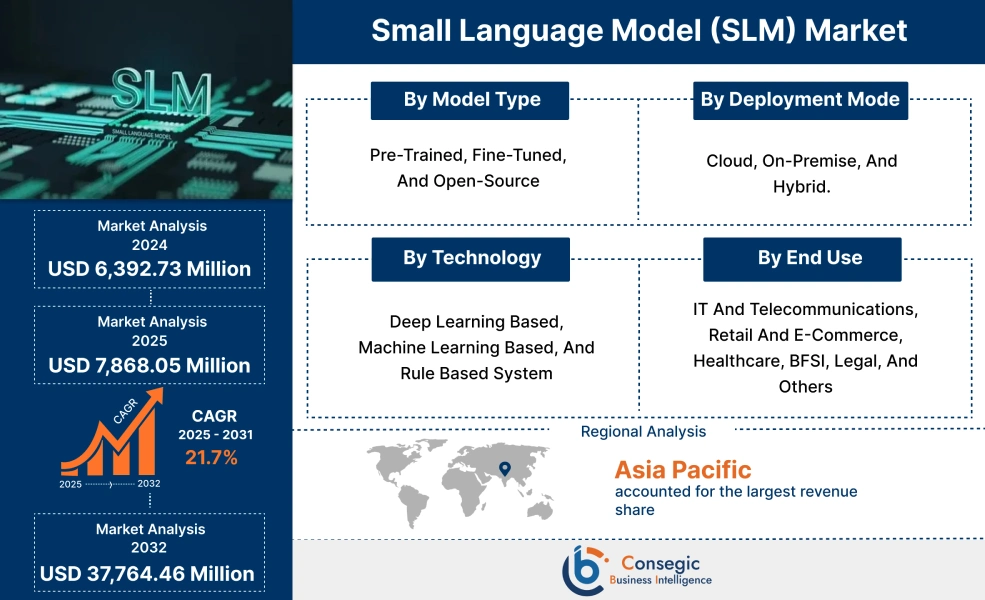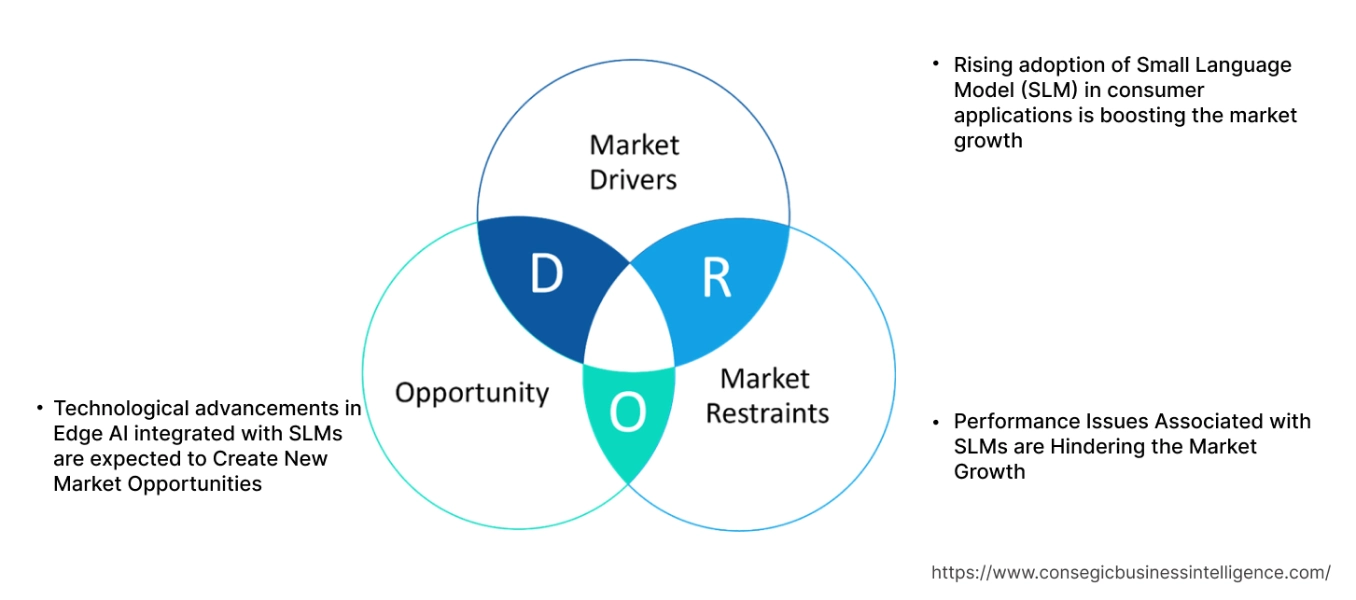Small Language Model (SLM) Market Size:
Small Language Model (SLM) Market size is estimated to reach over USD 37,764.46 Million by 2032 from a value of USD 6,392.73 Million in 2024 and is projected to grow by USD 7,868.05 Million in 2025, growing at a CAGR of 21.7% from 2025 to 2032.
Small Language Model (SLM) Market Scope & Overview:
Small Language Models (SLMs) are artificial intelligence models that are designed to process and generate human language. SLMs have a smaller number of parameters compared to large language models (LLMs), making them more lightweight and efficient. SLMs need less memory and computational power for training and deployment, making them suitable for edge devices and mobile apps. Due to their smaller size, SLMs are trained and fine-tuned more quickly, allowing for faster iteration and customization. SLMs are trained on smaller, more specific datasets, leading to specialized knowledge in particular domains. Their lower resource requirements make SLMs more accessible to a wider range of developers and organizations.
Small Language Model (SLM) Market Dynamics - (DRO) :
Key Drivers:
Rising adoption of Small Language Model (SLM) in consumer applications is boosting the market growth
SLMs are gaining popularity in consumer applications due to their efficiency, cost-effectiveness, and ability to run on-device. They are particularly well-suited for applications like intelligent virtual assistants, wearable devices, and automotive systems. Unlike larger language models, SLMs can be deployed on edge devices, reducing infrastructure costs and improving performance. They require fewer resources, making them more affordable and accessible for businesses and consumers. SLMs are ideal for on-device AI applications, as they can run locally without requiring internet connectivity or cloud processing.
- For instance, in July 2024, Mistral AI launched Mistral Nemo, a 12 B small language model. It has the ability to run locally without massive infrastructure setup.
Thus, the aforementioned factors are boosting the adoption of SLM in turn driving the small language model (SLM) market growth.
Key Restraints:
Performance Issues Associated with SLMs are Hindering the Market Growth
SLMs, are trained on vast datasets, and if these datasets contain biases, the models will likely inherit and amplify these biases. SLMs can generate text that reinforces harmful stereotypes or stereotypes based on gender, race, ethnicity, or other protected characteristics. When SLMs are used in applications like hiring or loan applications, biased outputs can lead to unfair or discriminatory outcomes. Due to their smaller size, SLMs struggles with complex language and nuanced understanding, potentially leading to biased interpretations or generalizations.
Thus, the market analysis shows that the aforementioned factors are restraining the small language model (SLM) market demand.
Future Opportunities :
Technological advancements in Edge AI integrated with SLMs are expected to Create New Market Opportunities
SLMs combined with Edge AI offer a powerful combination for deploying AI on devices with limited resources. SLMs, being smaller and more efficient than large language models, are well-suited for tasks where processing is done directly on the device, rather than relying on cloud-based infrastructure. This approach enables faster response times, improved privacy, and reduced bandwidth usage, making it ideal for a variety of applications. Edge AI with SLMs enables quick responses without relying on cloud connectivity, leading to a more seamless user experience.
Thus, the ongoing technological advancements are projected to drive small language model (SLM) market opportunities during the forecast period.
Small Language Model (SLM) Market Segmental Analysis :
By Model Type:
Based on the model type, the market is segmented into pre-trained, fine-tuned, and open-source.
Trends in the Model Type:
- Rising adoption of open-source SLMs for cost-effectiveness and transparency is boosting the small language model (SLM) market size.
- Increasing adoption of fine-tuned SLMs to cater complex tasks and enhanced accuracy is driving the market growth.
The pre-trained segment accounted for the largest revenue share of 46.80% in the market in 2024.
- SLMs are more efficient versions of Large Language Models (LLMs), often pre-trained on large datasets but with fewer parameters.
- The pre-training allows SLMs to learn general language patterns, enabling them to be fine-tuned for specific tasks with less data and computational resources.
- This two-step process, where knowledge is transferred from a general pre-trained model to a more specialized one, is known as transfer learning.
- Small, pre-trained language models offer several benefits including faster training times, lower computational costs, and enhanced customization, making them suitable for niche applications and resource-constrained environments.
- Therefore, the aforementioned factors are boosting the small language model (SLM) market growth.
The open-source segment is expected to register the fastest CAGR during the forecast period.
- SLMs paired with open-source benefits offer significant advantages, especially for businesses and developers seeking cost-effective and specialized AI solutions.
- Open-source SLMs further enhance these benefits by providing accessibility and transparency.
- Open-source SLMs allow for code inspection and modification, providing greater control and customization for specific needs.
- Thus, the small language model (SLM) market analysis depicts that the aforementioned factors are expected to boost the market trends during the forecast period.
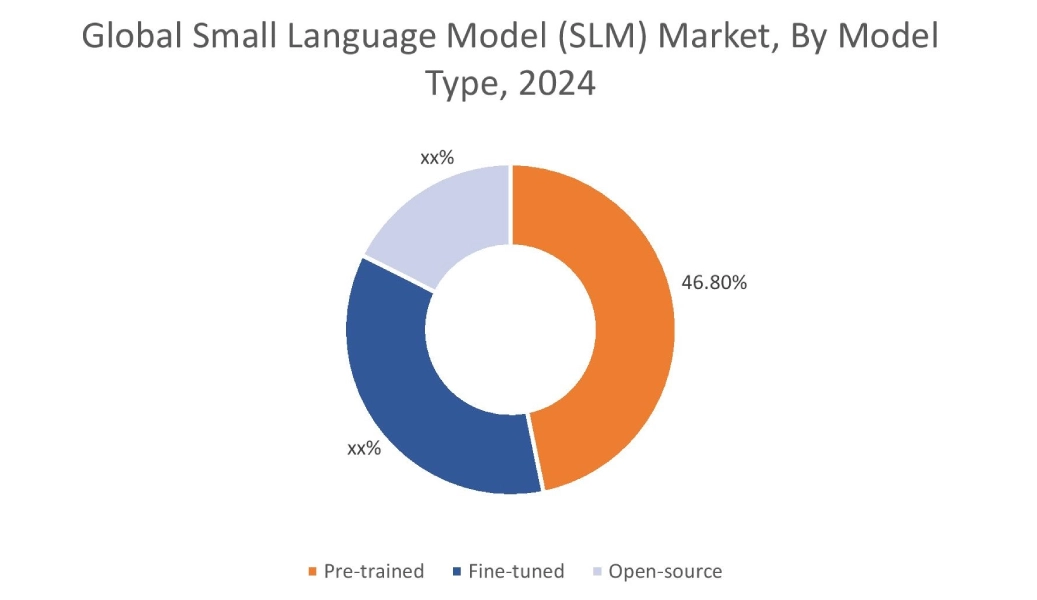
By Technology:
Based on the technology, the market is segmented into deep learning based, machine learning based, and rule based system.
Trends in the Technology:
- Rising adoption of deep learning based SLMs for efficient process and generate natural language is boosting the small language model (SLM) market size.
- Increasing trend in adoption for rule-based SLMs for enhanced efficiency and accuracy is boosting the market growth.
The machine learning based segment accounted for the largest revenue share in the market in 2024.
- SLMs utilize machine learning techniques for training, offering a more efficient and resource-friendly alternative to LLMs.
- Machine learning techniques, such as fine-tuning, are used to refine the SLM's performance and adapt it to more complex tasks.
- By training the model on a large dataset, it can learn to recognize patterns and make accurate predictions, even in situations that are not explicitly covered by the rules.
- Therefore, the aforementioned factors are boosting the small language model (SLM) market demand.
The rule based system segment is expected to register the fastest CAGR during the forecast period.
- Rule-based systems provide a structured way to define the knowledge and behavior of the SLM.
- These rules are used to guide the model's initial learning process, ensuring that it adheres to specific guidelines and constraints.
- SLMs, designed for specific tasks, are trained with rule-based systems to establish foundational knowledge and then fine-tuned with machine learning algorithms for more complex tasks, offering a balance between efficiency and accuracy.
- Thus, the aforementioned factors are expected to boost the small language model (SLM) market trends during the forecast period.
By Deployment Mode:
Based on the deployment mode, the market is segmented into cloud, on-premise, and hybrid.
Trends in the Deployment Mode:
- Rising adoption of hybrid deployment of SLMs for a strategic balance between cost and performance, ensuring that enterprises can scale AI deployments effectively.
- Increasing demand for adoption of on-premise deployment of SLMs for cost-effectiveness and control.
The cloud segment accounted for the largest revenue share in the small language model (SLM) market share in 2024.
- SLMs offer significant benefits when deployed in the cloud, particularly for their efficiency, cost-effectiveness, and ease of deployment.
- SLMs are cheaper to train and deploy than LLMs, reducing infrastructure costs.
- SLMs are easily scaled to handle increased workloads in cloud environments.
- Faster inference times and reduced latency make SLMs ideal for real-time applications.
- Therefore, the aforementioned factors are boosting the small language model (SLM) market expansion.
The on-premise segment is expected to register the fastest CAGR during the forecast period.
- Deploying Small Language Models (SLMs) on-premise offers numerous advantages, including enhanced security, cost-effectiveness, and control over data flow.
- SLMs are well-suited for edge applications and situations where sensitivity to data privacy is paramount, as they can operate directly on devices or within a secure, on-premises environment.
- SLMs are fine-tuned on proprietary data and configured with guardrails and safety filters to align with specific business needs and brand standards.
- Thus, the aforementioned factors are expected to boost the small language model (SLM) market opportunities during the forecast period.
By End Use:
Based on the end use, the market is segmented into IT and telecommunications, retail and e-commerce, healthcare, BFSI, legal, and others.
Trends in the End Use:
- Rising adoption of SLMs in retail to improve demand forecasting, personalize shopping experiences, enhance customer support, and optimize various retail operations.
- Increasing demand in adoption for tasks like clinical documentation, patient engagement, and real-time medical device analysis is propelling the market growth.
The IT and telecommunications segment accounted for the largest revenue share in the small language model (SLM) market share in 2024.
- SLMs are lightweight AI models used for Natural Language Processing (NLP) tasks, requiring less computational power and memory than their larger counterparts.
- They are becoming increasingly popular in the IT and telecommunication industries for various applications, including chatbots, text generation, sentiment analysis, and language translation.
- SLMs generate various types of text, including articles, reports, and even creative content, automating content creation tasks.
- SLMs analyze text and identify the sentiment expressed, helping businesses understand customer opinions and preferences.
- Therefore, the aforementioned factors are boosting the small language model (SLM) market expansion.
The BFSI segment is expected to register the significant CAGR during the forecast period.
- SLMs are increasingly used in the BFSI sector for various purposes, including enhancing customer experiences, streamlining processes, and improving decision-making.
- Their ability to process data efficiently and accurately, while maintaining data privacy, makes them a valuable tool for BFSI.
- SLMs are trained to understand customer inquiries and provide tailored responses, leading to more personalized and efficient customer service.
- SLMs power chatbots that handle routine customer inquiries, freeing up human agents for more complex issues.
- Thus, the market analysis depicts that the aforementioned factors are expected to boost the small language model (SLM) market trends during the forecast period.
Regional Analysis:
The regions covered are North America, Europe, Asia Pacific, the Middle East and Africa, and Latin America.
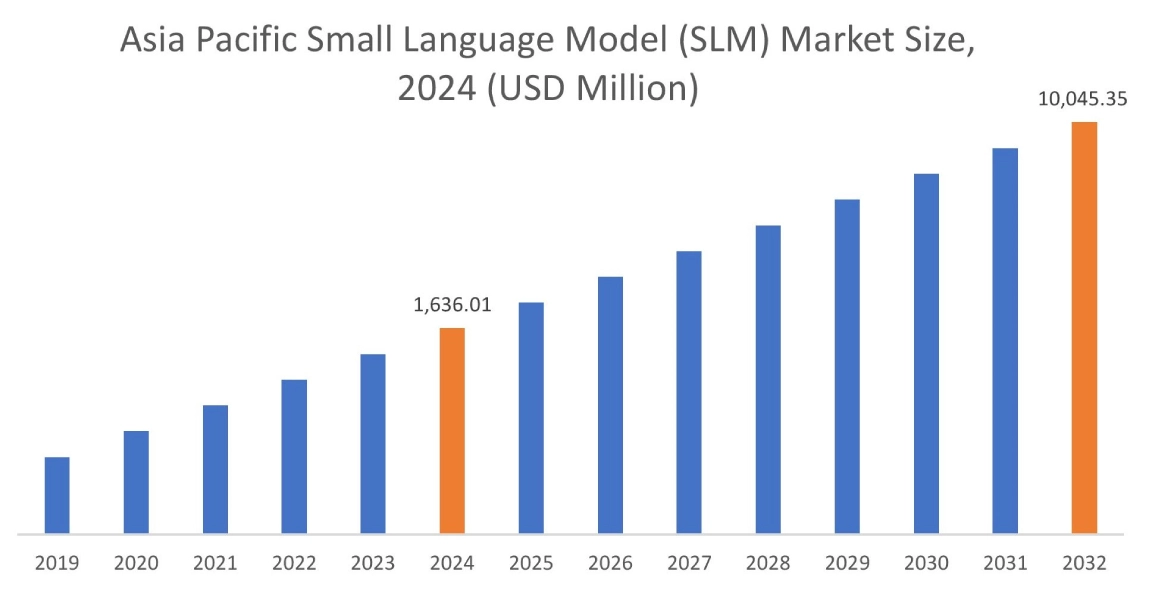
Asia Pacific region was valued at USD 1,636.01 Million in 2024. Moreover, it is projected to grow by USD 2,020.18 Million in 2025 and reach over USD 10,045.35 Million by 2032. Out of this, China accounted for the maximum revenue share of 33.60%. The small language model (SLM) market analysis depicts that the market in the region is primarily growing due to surge in AI adoption across various sectors including healthcare, finance, and e-commerce, fueling the need for efficient and scalable AI solutions.
- In Feb 2024, Alibaba Cloud launched Qwen 1.5, a small language model. It is operational in 12 languages, including Japanese, Arabic, Spanish, and others.
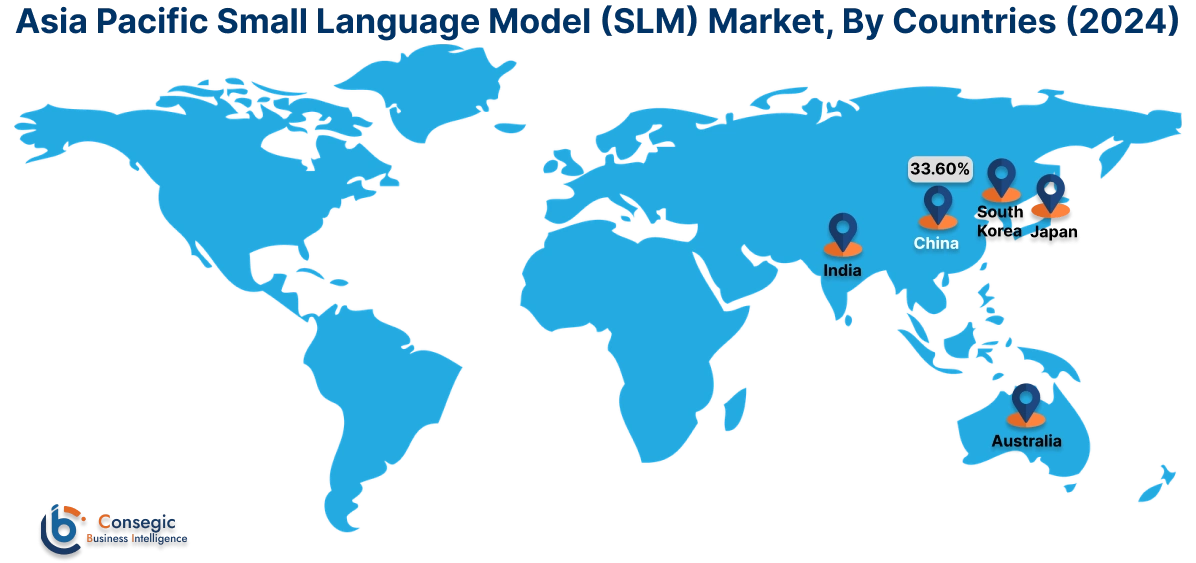
North America is estimated to reach over USD 15,974.37 Million by 2032 from a value of USD 2,715.84 Million in 2024 and is projected to grow by USD 3,341.41 Million in 2025. The market in the region is primarily growing due to a strong technological base, robust AI ecosystem, and widespread industry interest. This dominance is fueled by factors including high IT spending, technological expertise, and the presence of leading AI companies. The region also benefits from a concentration of AI research institutions and venture capital investments, accelerating SLM development.
In Europe, the market is driven due to rising demand for lower cost, faster training and inference SLMs. They are also well-suited for edge computing and domain-specific applications. In Latin America, Middle East and Africa, the market is growing due to the development of local AI ecosystems, and the need for specialized expertise.
Top Key Players and Market Share Insights:
The small language model (SLM) industry is highly competitive with major players providing solutions and services to the national and international markets. Key players are adopting several strategies in research and development (R&D), product innovation, and end-user launches to hold a strong position in the global small language model (SLM) market. Key players in the small language model (SLM) industry include -
- Alibaba Cloud (China)
- Mistral AI (France)
- Microsoft (USA)
- Stability AI (UK)
- DataLoop Ltd (Israel)
- NVIDIA (USA)
- OpenAI (USA)
- Alphabet Inc. (USA)
- Meta AI (USA)
- Cerebras (USA)
Small Language Model (SLM) Market Report Insights :
| Report Attributes | Report Details |
| Study Timeline | 2019-2032 |
| Market Size in 2032 | USD 37,764.46 Million |
| CAGR (2025-2032) | 21.7% |
| By Model Type |
|
| By Technology |
|
| By Deployment Mode |
|
| By End Use |
|
| By Region |
|
| Key Players |
|
| North America | U.S. Canada Mexico |
| Europe | U.K. Germany France Spain Italy Russia Benelux Rest of Europe |
| APAC | China South Korea Japan India Australia ASEAN Rest of Asia-Pacific |
| Middle East and Africa | GCC Turkey South Africa Rest of MEA |
| LATAM | Brazil Argentina Chile Rest of LATAM |
| Report Coverage |
|
Key Questions Answered in the Report
How big is the small language model (SLM) market? +
Small Language Model (SLM) Market size is estimated to reach over USD 37,764.46 Million by 2032 from a value of USD 6,392.73 Million in 2024 and is projected to grow by USD 7,868.05 Million in 2025, growing at a CAGR of 21.7% from 2025 to 2032.
What are the major segments covered in the small language model (SLM) market report? +
The segments covered in the report are model type, technology, deployment mode, end use, and region.
Which region holds the largest revenue share in 2024 in the small language model (SLM) market? +
North America holds the largest revenue share in the small language model (SLM) market in 2024.
Who are the major key players in the small language model (SLM) market? +
The major key players in the market are Alibaba Cloud (China), Mistral AI (France), NVIDIA (USA), OpenAI (USA), Alphabet Inc. (USA), Meta AI (USA), Cerebras (USA), Microsoft (USA), Stability AI (UK), and DataLoop Ltd (Israel).
